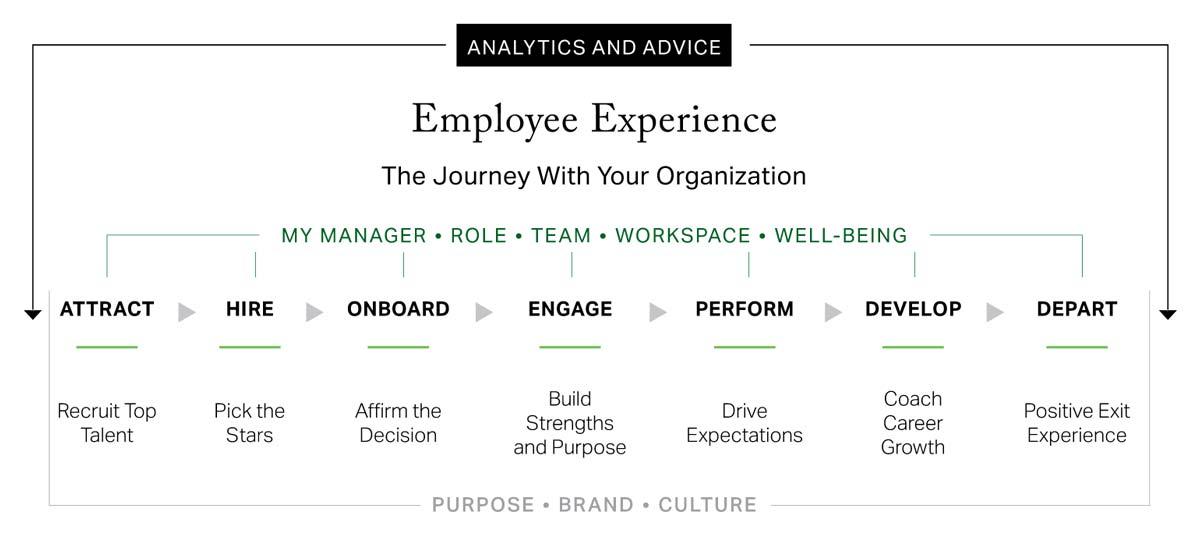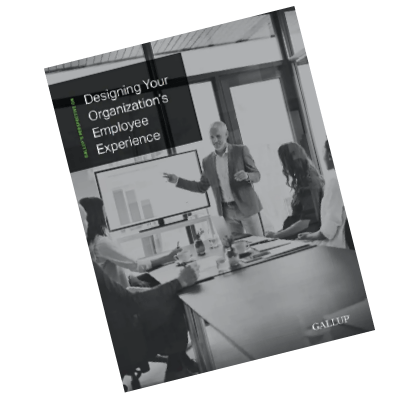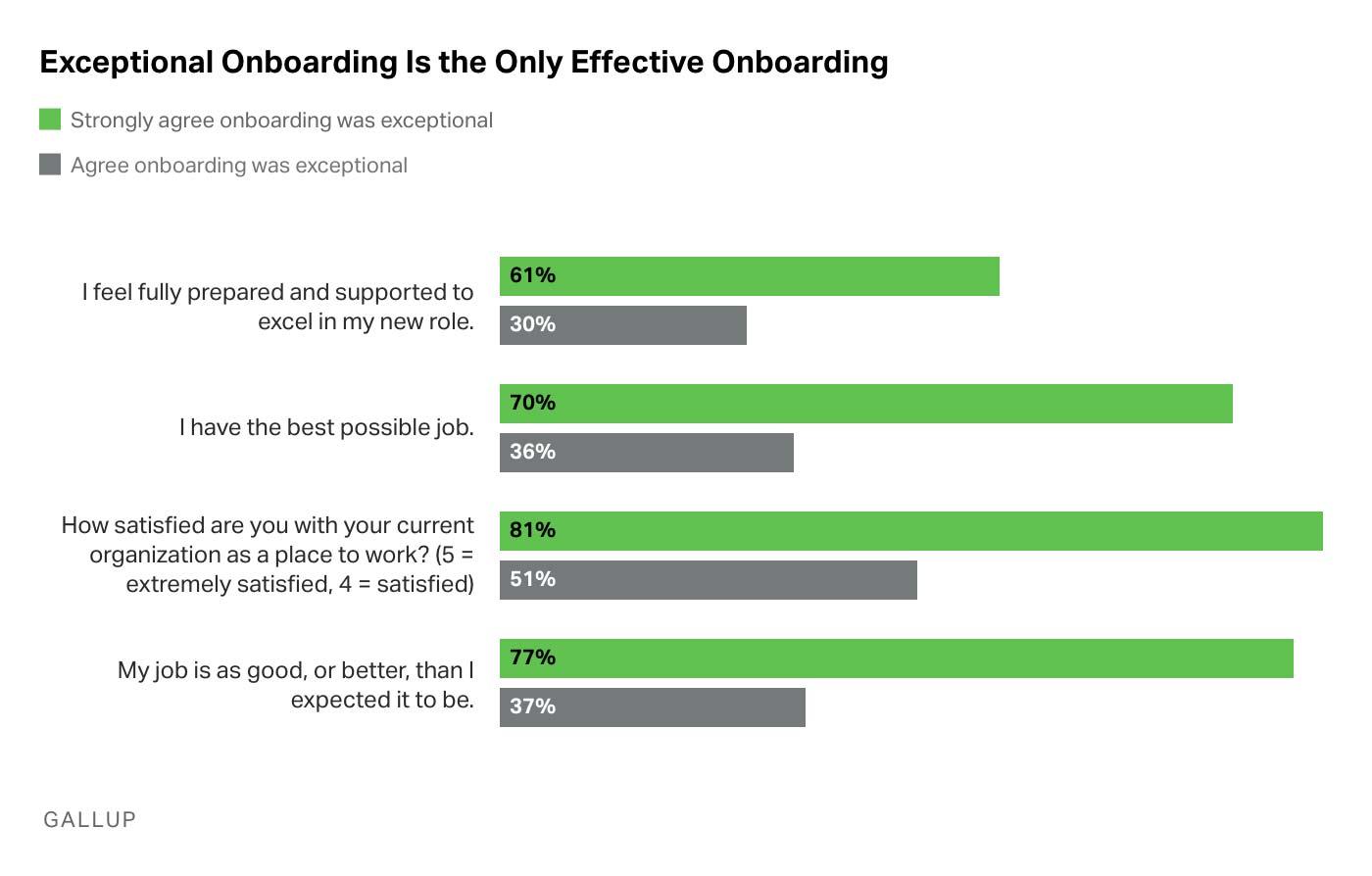How to Improve the Employee Experience
- What Is Employee Experience
- Developing an Employee Experience Strategy
- What Are the 7 Stages of the Employee Life Cycle?
- Improving the Employee Experience at Each Stage of the Employee Life Cycle
- The Employee Life Cycle's 3 Crucial Stages: Employee Engagement, Performance and Development
- What Are Some Employee Experience Best Practices?
- Why Should Employee Experience Be Your Top Priority?
- Improving the Onboarding Experience
- How to Improve Your Employee Exit Program
- Employee Experience Solutions: How Gallup Can Help
01 What Is Employee Experience?
The employee experience is the journey an employee takes with your organization.
At its heart is this question: How are employees experiencing their workplace?
The answer is the sum of all interactions an employee has with an employer, from prerecruitment to post-exit. It includes everything from major milestones and personal relationships to technology use and the physical work environment.
Why does the employee experience matter?
All of the individual moments of an employee's experience play a role in how a worker feels about an employer's purpose, brand and culture.
These feelings directly affect employee engagement, retention, performance and development.
One-third of global employees strongly agree with the statement, "The mission or purpose of my organization makes me feel my job is important."
By doubling that ratio, business units have realized a 34% reduction in absenteeism, a 41% drop in safety incidents and a 19% improvement in quality.
The employee experience can also influence an employee's decision to return to a former employer and their likelihood to recommend an organization to other high-talent individuals, affecting the organization's reputation and talent acquisition.
World-class employee experiences attract top talent through strong company branding, drive high performance through meaningful manager-employee relationships, and create valuable brand ambassadors long after employees have left your organization. World-class employee experiences can also lead employees to choose to spend their career with your organization -- because your organization provides them the best opportunity to develop and continually improve their workplace wellbeing.
As a result, improving the employee experience should be a strategic priority for every organization.
02 Developing an Employee Experience Strategy
Where should an organization begin when developing a new employee experience approach? What matters most? What changes are proven to create real value for an organization?
The following are three key phases that every organization should consider when developing an employee experience strategy:
- Align your employee experience with your purpose, brand and culture.
- Focus on the seven essential stages of the employee life cycle.
- Remember the core needs at the heart of every stage of the employee life cycle.
Align Your Employee Experience With Purpose, Brand and Culture.
The employee life cycle and the experiences within it should be uniquely built to reflect your company purpose, workplace culture and employer branding. (What is the employee life cycle?)
For example, if your organization promotes a customer-centric culture, how is that company culture experienced by employees in your hiring process and in your onboarding process? Where does it show up on an employee performance review? How might it be expressed in the way you say "goodbye" to employees who are moving on or retiring?
Rituals play an important role in defining an organization's culture. The experience of onboarding a new hire, an employee performance review, or a firing not only influence the individual, but they also express "who we are" and "what we care about" to the rest of the team. Employees are often spectators of or participants in the full employee life cycle of their peers. Watching a friend receive public, authentic recognition may reinforce a positive workplace culture as much as personally receiving recognition.
Building your employee experience design should begin with a clear understanding of your organization's brand, its purpose and the culture you want to create. If you want to have a unique and powerful workplace experience, every part of the employee life cycle should be implemented according to your distinctive organizational identity.
Focus on the 7 Essential Stages of the Employee Life Cycle
The employee life cycle identifies the seven major stages that employers need to get right within the employee experience.
These landmark elements contain both key milestones, such as attraction, onboarding, and exit, and also continual demands, such as providing an engaging workplace, managing performance, and developing employees. They capture the most significant employee-employer interactions that shape employee perceptions.
For organizations just beginning to think about their employee experience, examining the seven stages in the context of your company culture is a good place to start. The employee experience has to be well-thought-out and activated within each of the employee life cycle stages.
Much like a consumer experience, one negative experience in the process can create problems throughout the system. An employee experience framework takes all of these elements into consideration when forming a talent strategy.
Remember the Core Needs at the Heart of Every Stage
A few constants in your workplace have a significant influence on the quality of the employee experience at each stage of the employee life cycle:
- the quality of the relationship that an employee has with their manager
- the clarity of their role
- the value they bring to their team
- the space and place where they work
- how their work affects their overall wellbeing
03 What Are the 7 Stages of the Employee Life Cycle?
The employee life cycle consists of the seven critical stages that an employee experiences with your organization. These are the stages of the employee experience in which employers have the greatest influence on how their employees perceive them. Through these critical stages, employers can make targeted efforts and apply best practices to affect employee engagement, employee performance and talent acquisition -- the ability to hire great talent in the future.
Gallup has identified seven stages of the employee life cycle -- the stages an employee goes through with an organization, from attraction to going through the hiring process through employment to eventual departure.
More important than the life cycle, however, is the employee experience -- the journey people take with your organization and the interactions they have with managers and associates at each stage of the employee life cycle.

The experiences employees have at each stage directly affect employee performance and your employer branding.
The following are the kinds of questions organizations might ask when looking at their current HR processes through an employee experience lens:
Attract
What elements of our culture are we highlighting to attract top talent?
Hire
Does our hiring process feel fair? Does our process pick stars?
Onboard
Do we affirm the decision employees made to join us? Do new hires experience our values during the employee onboarding process?
Engage
Do our employees show up every day enthusiastic and involved in their work? Do we build on strengths and purpose?
Perform
Does each employee performance review seem fair and accurate? Are we driving expectations to higher levels?
Develop
Do our top performers see a future with us? Do we offer flexible, personalized career paths? Do we continually coach career growth?
Depart
Who are our talent competitors? Why does our best talent leave? Does our exit program create a positive experience?
04 Improving the Employee Experience at Each Stage of the Employee Life Cycle
Making improvements to the employee experience can begin with a simple thought exercise.
Imagine an employee's path through your employee life cycle, from a first-person point of view. What does it feel like to be recruited? Hired? Managed? What does it feel like when you leave the organization? Imagining and measuring these experiences can help leaders better see the human element of the workplace and, as a result, create a better employee experience.
The following are important considerations for improving the employee experience at each stage of the employee life cycle.
Attract: Recruit Top Talent

When considering whether or not to take a job with a different organization, 59% of employees rate having greater work-life balance and better personal wellbeing as a very important attribute.
Companies spend a lot of time and money marketing to loyal customers, but they often neglect developing an equally strong focus on employer branding. Today's workplace is highly transparent. Internal employee experiences can quickly shape your organization's external reputation, sending signals about what your organization stands for. High-talent individuals are particularly interested in working for organizations that have strong company purpose and values -- and that live them out authentically.
Hire: Pick the Stars

From an employee perspective, the hiring process should be clear, engaging and aligned with your employment brand and overarching employer branding strategy. Managers should aim for both a strong fit to role and fit to culture. It should also feel -- and be -- fair and unbiased. To improve the odds of making a great hire, organizations need to use objective, scientifically rigorous evaluations that can predict performance and balance out common manager biases.
Onboard: Affirm the Decision

Only 12% of employees strongly agree that their organization does a great job of onboarding.
New employees come to your organization with a lot of personal and emotional questions: How do we do things? What are my strengths? What is my role? Who are my key partners? Who are my friends? What does my future here look like?
Onboarding should not just be a one-way communication to employees. Employers should help employees quickly socialize into their team, resonate with the organization's purpose, learn how the organization functions and empower the employee to achieve high performance quickly.
Engage: Build Strengths and Purpose

Only 23% of employees, globally, and 31% in the U.S. are engaged.
Employee engagement is about much more than making sure employees are satisfied with where they work. Gallup research finds that workplace perks matter less than the relationship between a manager and an employee. Employees today are looking for a coach who cares about them, keeps them accountable and focuses on future excellence and career growth opportunities.
Perform: Drive Expectations

Just two in 10 employees strongly agree that their performance is managed in a way that motivates them to do outstanding work.
Many organizations are realizing that delivering an annual employee performance evaluation is not enough to improve employee performance. In fact, it often backfires, decreasing performance instead. Employees respond best to regular informal feedback on their work and frequent praise and recognition for excellent work. An employee also needs to feel that their performance -- reflecting their individual achievement, team collaboration and customer value -- is reviewed in a fair and comprehensive way.
Develop: Coach Career Growth

One of the top reasons people change jobs today is "career growth opportunities." For many of today's workers, the "corporate ladder" is broken.
Changes to job titles and pay raises are often too infrequent to satisfy the universal human desire to grow and develop. Employees need to see a path forward in your organization: opportunities to gain new skills, work with new people or enjoy greater autonomy. These professional development opportunities happen most optimally through ongoing coaching conversations.
Engaged employees report having meaningful feedback at least once per week. Ongoing conversations can take the form of quick 10- to 30-minute connections, deeper developmental feedback or semiannual employee progress reviews.
Depart: Positive Exit Experience

One in two U.S. employees are open to leaving their organization.
An employee exit can be the most emotional and uncertain phase of an employee's journey. At its best, exiting is the final stage of an ongoing coaching conversation about the employee's experience, performance, development and perceptions of the organization. Regardless of the terms, employees have a need to feel heard and to be appreciated for their contributions. An excellent exit program generates proud "alumni" and brand ambassadors who bolster the organization's reputation, paying long-term dividends for your talent strategy.
05 The Employee Life Cycle's 3 Crucial Stages: Employee Engagement, Performance and Development
Employee engagement, performance and development are the three stages that capture most of the day-to-day experiences of employees. They are also the responsibility of managers: engaging the team, coaching for high performance, and shaping personalized, long-term growth.
For this reason, the hiring, training and developing of great managers should be at the core of any employee experience strategy. A manager's own employee experience is central to building a culture of high engagement -- and manager engagement and wellbeing are often in no better shape than those of the employees they manage.
The employee experience is not a replacement for employee engagement.
Employee engagement involves the basic psychological needs that must be met for employees to perform their specific roles well. An engaged employee "shows up," physically, emotionally and cognitively. They are enthusiastic about what they have to do, and they naturally find ways to improve performance and excel. In short, engaged employees generate most of the creativity, innovation and excellence in your organization.
Unfortunately, far too many employees do not have these basic needs met. For example, globally only 38% of employees strongly agree that they have the materials and equipment they need to do their work right and 35% that they have the opportunity to do what they do best every day.
In the employee life cycle, employee engagement is at the center, not only literally as the fourth of seven stages but also theoretically, as most stages of the employee life cycle play some role in employee engagement -- for example, knowing how your role fits into your company's mission should be part of any onboarding process. However, engagement involves the daily execution of one's role, and increasing employee engagement is primarily the responsibility of managers. Gallup's analysis shows that the manager alone accounts for 70% of the variance in team engagement.
In the employee life cycle, engagement appears before performance because it is foundational to high performance and ongoing employee development. With engagement, high performance is easy to coach. Without engagement, high performance is unlikely.

How effective is your employee experience strategy? Bring in our experts to map, measure and enhance the moments that matter to your employees.
Performance appears before development because the best form of development happens as employees are experiencing their work with great coaching -- involvement in setting goals and receiving meaningful feedback. When employees have their basic psychological needs met, they can focus on mastering their tasks and producing exceptional outcomes.
The manager alone accounts for 70% of the variance in team engagement based on:
- the manager's innate tendencies
- the manager's engagement
- the employee's perception of the manager's behaviors
06 What Are Some Employee Experience Best Practices?
Employees have a stable set of core needs across all stages of the employee life cycle. Learn about the following core needs and best practices for getting them right.
Manager:
The manager-employee relationship is the most important relationship at every stage of the employee journey. Managers affect employees' work experience in how they engage them and develop their strengths. Managers are in a position to continually help the employee see their current value and future in the organization. That means any employee experience strategy must prioritize the identification and development of great managers.
Role:
"What is expected of me?" is a simple question, but it often goes unanswered in the workplace. In fact, about half of U.S. employees know what is expected of them at work. Each employee's role and clarity of job responsibilities are initially defined during role orientation. But the role is redefined through ongoing involvement in goal setting, meaningful feedback and semiannual reviews.
Team:
People perform at their best when they respect the people they are working with and trust that they are going to perform at their best. They also need to see how they are a valued member of their team. Employees need to know who their trusted partners are during onboarding, and then their partners continue to evolve as the employees learn whom they can win with throughout their tenure.
Workspace:
An appropriate physical environment is a psychological necessity for getting work done. A supportive work environment should give employees the freedom to work in the ways they feel are best -- for example, with spaces to collaborate or work privately, depending on the task at hand. Light, temperature, ergonomics, noise and distractions are other employee experience tools that dramatically affect the quality of the workplace.
Wellbeing:
It's difficult to imagine a great employee experience without frequent "good days." Gallup's global research has found that what makes a good day (and a good life) is surprisingly universal. It includes factors such as having a life full of love, having the energy to do what you want to do and giving back to one's community. Gallup identifies five elements of wellbeing: career, social, financial, physical and community.

How are your employees experiencing the workplace? Find out with Gallup's Q12 engagement survey, advice and insights.
07 Why Should the Employee Experience Be Your Top Priority?
Today's employee is a consumer of the workplace. Employees are no longer satisfied with clocking in and out and receiving a paycheck. They are looking for meaning in their work, a supportive, collaborative environment, and an employer that can match the lifestyle they want.
Gallup recently asked U.S. employees what attributes are the most important to them when deciding whether to accept a job offered by a new employer. The majority of employees (59%) say a role that allows them to have greater work-life balance and better personal wellbeing is "very important" to them.
46% of Americans say it is a good time to find a quality job.

The influence of social media also plays a role. Workplace moments can quickly go viral, even within an employer's internal communication tools like Slack, an online communication and collaboration hub for workplaces. Tools like this provide a great opportunity to promote an organization's brand in an authentic way and enhance the digital employee experience. They also can cause employer branding headaches when leaders must deal with incomplete perceptions about their workplace or with negative reviews on websites like Glassdoor.
No doubt the stakes for employers are higher than ever when it comes to reputation, culture and talent. Employers are beginning to ask deeper, tougher questions about what makes a great employee experience.
08 Improving the Onboarding Experience
Employees who strongly agree their onboarding process was exceptional are nearly three times as likely to say they have the best possible job.
Onboarding is the critical stage that connects the talent acquisition process to long-term, sustainable performance. It fulfills promises made during the recruitment and hiring processes so employees don't experience a bait-and-switch scenario, and it lays the foundation for the rest of the employee experience.
Perhaps more than any other stage, onboarding plays a critical role in your employees' perceptions of your organization. Employees often establish their opinion of your culture in the first few months, and misperceptions can take a long time to fix.
After experiencing onboarding at their organization, 29% of new hires say that they feel fully prepared and supported to excel in their new role.
For many employees, the best onboarding experience includes an avalanche of information, from computer setup to ethics training. Gallup recommends that instead of starting with requirements, HR leaders should begin with the fundamental psychological needs that every new employee has.
Imagine an onboarding process where all five of the following questions get answered comprehensively. The result is an employee who feels bonded to their team, knows what their talents are and what they care about, and understands what they are supposed to do. They also know the direction their career is taking. That's an employee who is prepared to fully embrace their new role and is likely to succeed at it.

Rethinking the employee experience at your workplace? Keep the conversation going by sharing our paper, Designing Your Employee Experience.
The 5 Questions Every Onboarding Program Must Answer
- "What do we believe in around here?"
Culture matters. It's how you live out your beliefs, values, mission and company purpose. It defines who gets rewarded, how decisions get made and how problems get resolved. It's the way people behave every day in meetings, over email and in person. To be successful, new employees need to know -- and experience -- your company culture firsthand. When employees strongly agree that they have a good understanding of "how we do things at this organization," they are 4.7 times more likely to strongly agree their onboarding process was exceptional.
- "What are my strengths?"
People enjoy doing what they are good at. Investing time and resources into discovering and developing an employee's strengths paves the way for consistently excellent performance. Employees who strongly agree they can apply their strengths every day at work are 3.5 times more likely to strongly agree their onboarding process was exceptional.
- "What is my role?"
"What is expected of me?" is a simple question, but it often goes unanswered in the workplace. Managers are key here. They must help employees understand their job expectations and how they relate to teamwork and the business needs of the organization. When employees strongly agree they are confident in their ability to excel in their role, they are 1.8 times more likely to strongly agree their onboarding process was exceptional.
- "Who are my partners?"
People perform at their best when they respect the people they are working with and trust that they also are going to perform at their best. Building trust takes time, but there's much that managers and organizations can do to develop trust and collaboration between new employees and their teams. When employees strongly agree they have partners they can always rely on at work, they are 1.9 times more likely to strongly agree their onboarding process was exceptional.
- "What does my future here look like?"
New employees arrive at the office filled with high expectations. But those positive feelings evaporate if they gradually realize they aren't going anywhere. For this reason, a path for future growth must be front and center throughout their onboarding journey. Employees who strongly agree they have a clear plan for their professional development are 3.5 times more likely to strongly agree that their onboarding process was exceptional.
Onboarding Best Practices: Take These 6 Steps
Based on Gallup's analysis of employee onboarding experiences, six actions will improve organizations' programs for new hires -- moving them from average to exceptional.
Step 1
Extend the employee onboarding journey to span the entire first year.
Although formal orientation may end in a week, it takes months for new employees to reach their full potential. Employee engagement may be high at first, but after a few months, the essential elements of a job -- the manager relationship, expectations, team dynamics -- come to the forefront. This is when many employees decide to stay or leave.
Organizations need to think of onboarding as a year-long process that offers employees many opportunities to build relationships with team members, learn and grow, and connect with their manager through regular check-ins.
Ongoing feedback should lead to focused manager-employee conversations about what's working and what's not. Such check-ins are not evaluations or employee performance reviews. The goal of these conversations is to deepen the relationship between employee and manager -- an essential key to success in any role.
Step 2
Make sure your onboarding experience aligns with your employee value proposition.
Today's employees are consumers of the workplace. When they accept a job offer, they want to get what they expect when they start working. Their expectations include all aspects of their job, from pay and role to company culture and career growth opportunities. Sometimes these are explicit in promotional materials, and other times they are not.
HR leaders should clearly define the expectations that employees have when they are hired, and they should make sure onboarding addresses each item.
Step 3
Answer the five questions of onboarding.
When employees can emphatically agree with Gallup's five questions of onboarding, your company culture and talent development strategy are primed for success. All five questions are critical. Employees fundamentally need three of these questions answered to know how to meet their most basic job expectations: What do we believe in around here? What is my role? Who are my partners?
Step 4
Add experiences that make new employees feel your distinctive culture.
To be successful, new employees need to understand your culture and believe that they fit into it. Hiring for culture fit is important, but it means little if employees don't feel invited to participate in that culture. Organizations need to create experiences that bring their culture to life in social and emotional ways.
Step 5
Train leaders, managers and teams to take responsibility for creating the best employee onboarding experiences.
Onboarding is all about connection. Most information received at orientation is forgotten, but the relationships employees build in the first few months on the job may last the rest of their tenure. Feelings of belonging, trust and respect can't be created by an onboarding checklist. They require conversations and experiences with leaders, managers and team members.
A brief, genuine encounter with a leader can leave a deep impression on a new employee. A meaningful conversation with a manager about deep topics -- professional dreams, passions, talents -- can reassure someone that they are in the right place.
Step 6
Combine your onboarding analytics with performance data to gain deeper insights.
An effective onboarding program should have a proven positive effect on engagement, performance and employee retention strategies. Surveys provide valuable insights into the onboarding experience and linking rigorous survey data to employee behavior (such as a premature exit) and business outcomes is even more valuable. On a tactical level, leaders can use onboarding data to identify top reasons that employees are not connecting well with the organization. Based on what they learn, leaders can provide managers with additional resources and recommendations for correcting issues and engaging their new hires.
From a strategic perspective, leaders can combine onboarding data with data from other stages of the employee life cycle -- such as hiring, performance and employee exit interview data -- to see which parts of the employee experience need improvement. Leaders may discover that onboarding can illuminate bad hiring practices, failed delivery on an organization's employee value proposition or a disconnect from the organizational culture -- which all can lead to performance issues later.
The Importance of the Manager in Onboarding
The manager-employee relationship is the most important relationship at every stage of the employee journey. Gallup has found that the manager accounts for 70% of the variance in team engagement.
Too often, managers are either not included in the onboarding process, or they are given a simple onboarding checklist to complete. Such an approach turns onboarding into a formality rather than an experience that makes an employee feel good about their decision to work for you.
When managers are disconnected from onboarding, it also can create a gap between corporate policies and the everyday work experience. Your managers may tell a very different story than what employees initially heard about your company culture and expectations. This can cause confusion for new employees who easily notice misalignments and hypocrisy.
Most importantly, managers must individualize the onboarding program to each employee's role and strengths. HR typically constructs onboarding to be generally applicable to everyone across the organization or to specific job families.

So, beyond HR's planned orientation and additional activities, it's up to the manager to show employees how the onboarding experience is put into practice over time on their team and in their role. For example, when a company has a flexible work environment, expectations may be different for a graphic designer than an administrative assistant.
Managers need to set expectations and individualize whenever possible.
09 How to Improve Your Employee Exit Program
Less than half of employees (45%) are satisfied with how their organization handled their exit process, and only 24% are extremely satisfied with the process.
A comprehensive exit program can uncover where your employees are going and why. When organizations combine exit surveys and interviews with other performance data, they can identify breakdowns in the employee life cycle and the key risk factors that predict employee turnover.
At its best, an employee exit process that addresses the following considerations can add meaningful business insights to your talent acquisition and management practices:
1. Know why your best employees stay.
A successful exit program should investigate why your veteran top performers are still with you.
Gallup recommends that managers have ongoing "stay conversations" with top performers. Ongoing stay conversations are essential to learning what is working well for your employees -- so you can retain them better.
Stay conversations:
- can be a formal interview or part of regular coaching conversations
- should uncover which aspects of your culture matter most to your employees
- should invite your best people to voice their unspoken, unmet needs
If you build your organization around your best people, you not only keep more of them, but you also attract more talented people like them.

2. Understand the exit experience from the employee perspective.
An employee's exit from your organization can be one of the most difficult and challenging phases in the employee life cycle for both the organization and the employee.
And what happens during this stage matters a lot: Employees who have a positive exit experience are 2.9 times more likely to recommend their organization to others than are those who have neutral or negative experiences. Ideally, turnover is a positive experience for both the person who departs and for your organization -- the employee leaves on good terms and talks positively about your organization.
A successful exit has three key elements:
Employees feel heard. There is an 85% likelihood of a positive exit experience when employees say they had all of the following experiences with their previous organization:
- A supervisor or leader talked with them in the three months before leaving about their job satisfaction, the future of their career with the organization and what it takes to perform effectively.
- They talked with someone about leaving the organization before resigning.
- They feel there is nothing their manager could have done to prevent them from leaving.
They feel proud of their contributions. Less than half of former employees (40%) strongly agree that they are proud of their work at the organization. Except in cases of terminations due to unethical behavior, make sure everyone who leaves your organization knows what they contributed and that it was appreciated. When employees have a positive exit experience, they are 32% more likely to say they are proud of their work.
They leave as brand ambassadors. No organization can turn around every disgruntled employee. But exits are your opportunity to leave employees with a final impression of your employer branding, mission and company culture. Only 12% of former employees strongly agree that they consider themselves part of their previous organization's alumni network, and just 10% strongly agree they would recommend the organization as a place to work.
A comprehensive exit program includes purposeful check-ins with alumni that can keep them in the loop on new employment or referral opportunities. A loyal alumni network can substantially strengthen the reputation of your organization, lead to new business opportunities and attract top talent to the organization.
3. Start collecting and leveraging the right information.
Some leaders simply don't value exit program data. Sometimes they are right to do so -- when response rates are dismal and questions are poorly written. In many cases, the data from the employee exit survey are ignored and even disputed in terms of validity by stakeholders. However, exit data can be immensely valuable for an organization if an exit program includes the following elements:
Multiple Sources
The best exit programs include more than just a survey. They offer in-person or phone interviews, manager and peer feedback, and after-action reviews with a team.
Ongoing Discussion
Monitoring and evaluating exit data should be an ongoing discussion for leaders, not an annual meeting. This process includes stay conversations and surveys that can address issues before they end in a surprise departure.
Connections to Outcomes
An exit survey comes alive when it's combined with other data points, like performance, employee engagement, demographics and customer metrics. Exits can be emotional, and memories can be fallible. Getting a clear picture of the situation is key.
Predictive Analytics
Employee exit surveys and interviews are often downplayed because they occur after the fact. Nevertheless, the foundation for accurately predicting future turnover --something every leader wants -- begins with a commitment to targeted and consistent data collection.
4. Form an exit action team to apply data insights.
The only effective data are those that an organization acts on. To learn from losses, predict future turnover and turn employee departures into a driver of positive workplace culture, organizations need to develop systematic, data-driven exit programs.
Gallup recommends forming an action team responsible for making change. Exit action teams should combine exit data with key performance indicators and other data points from the employee life cycle to paint a comprehensive picture.
Consider the following scenarios based on real Gallup client challenges:
Why are our best employees leaving?
Problem: You are losing your best employees, but organizational leaders disagree on the cause and the solution. Increasing pay is an obvious option, but you already have the highest pay in the industry.
Action Team Response: Exit interviews reveal which competitors are getting your best people. They also show that remote work and family-related flexibility, not pay, are the top reasons that employees are leaving. It's time to update your flexible work arrangement policy and test remote work options for some teams.
Why does everyone leave so soon?
Problem: Your organization is able to attract great people, but they leave within a year or less of their hire date.
Action Team Response: From exit survey and interview feedback, you discover that employees are experiencing "buyer's remorse" during their onboarding process when they discover that many of the negatives about their role were hidden during the recruitment and hiring processes. In response, hiring managers need to be trained to tactfully but truthfully paint a picture of the role to increase employee success rates. The exit data also reveal opportunities for improving teamwork and relationships with managers during the new hire training process.
How do we fix department x?
Problem: Although turnover in your organization is relatively low, one department has extremely high turnover. Everyone you ask has a different reason why.
Action Team Response: A comprehensive exit survey reveals that leavers are frustrated by unclear expectations and lack of support from their manager. Those who receive the least amount of feedback from their manager are the most at risk of burnout and departure. Targeted training with department leaders can show them how to increase the frequency of supportive coaching conversations.
How should we transform our organization to attract the best?
Problem: You are a 100-year-old organization with a traditional organizational structure, competing for fresh talent against newer, more exciting businesses. How can you change with the times but keep the aspects of your brand that make you special and unique?
Action Team Response: Exit interviews reveal that in-office perks are not a high priority among your top performers. Instead, they want more social opportunities with coworkers and more professional mentoring relationships with your most experienced veterans.
.
10 Employee Experience Solutions: How Gallup Can Help
Gallup knows more about today's employees than anyone else in the world.
Gallup can help you design your employee experience and employee life cycle, from attraction strategy to exit surveys. We help leaders answer their most pressing questions:
- How can we hire the most talented people for our organization?
- How do we engage and develop employees?
- Do our employees truly believe in our culture?
Gallup combines decades of global research with today's latest data science to provide advice and analytics to the world's leading organizations, governments, universities and corporations.